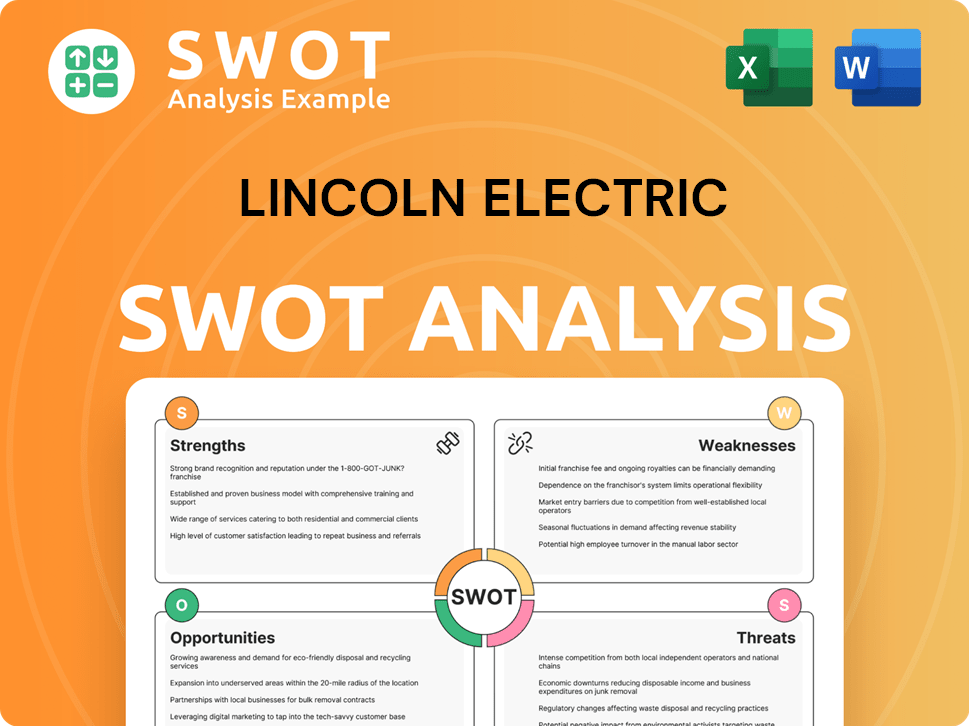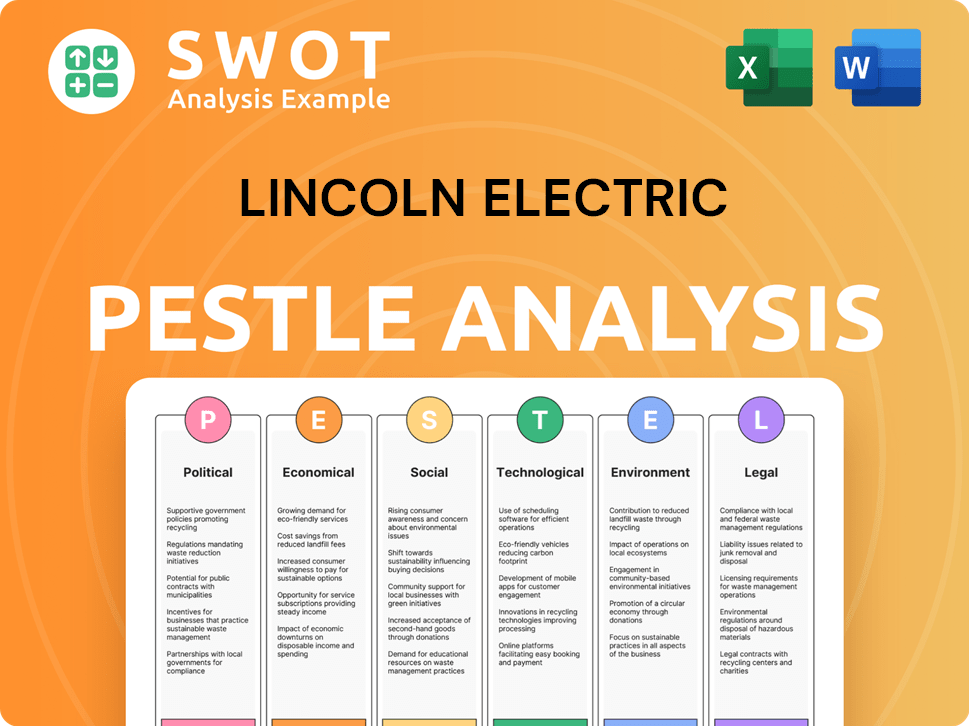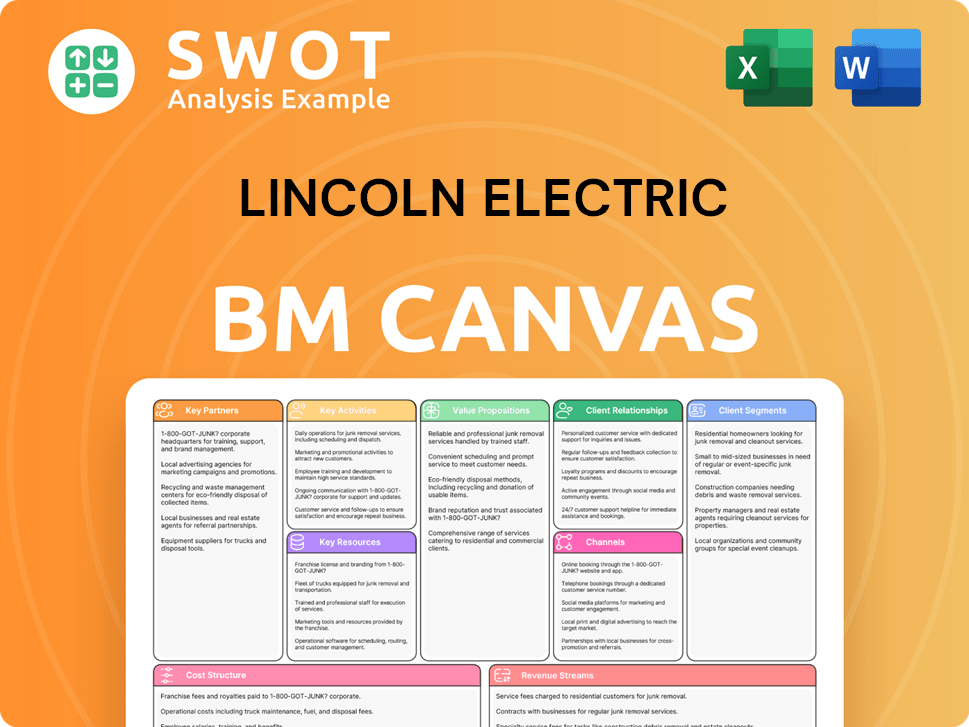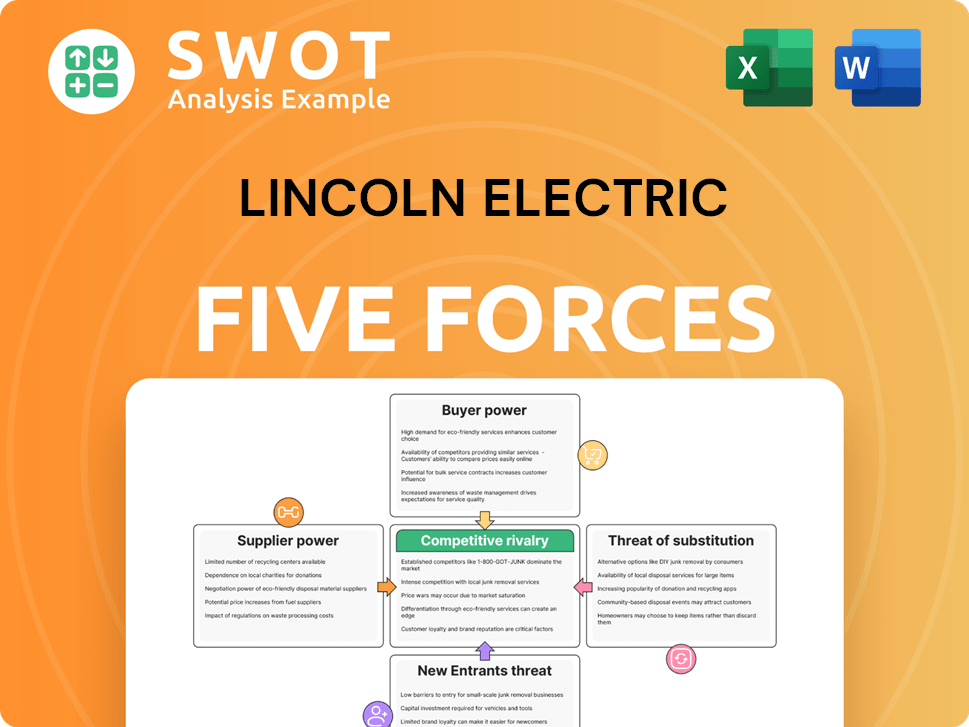Lincoln Electric Bundle
How Did Lincoln Electric Become a Welding Giant?
Imagine a company born in 1895 with a mere $200 and a big dream. That's the story of Lincoln Electric Company, a Lincoln Electric SWOT Analysis of a welding company that has evolved from making electric motors in Cleveland, Ohio, to becoming a global leader. Its journey is a fascinating study in industrial history, innovation, and unwavering commitment to its employees and customers.

From its early years, Lincoln Electric's commitment to innovation and its unique corporate culture have been instrumental in its success. This brief history of Lincoln Electric explores how the company navigated challenges and capitalized on opportunities, transforming the welding industry. Understanding the company's timeline and key milestones provides valuable insights into its enduring legacy and future prospects within the welding industry.
What is the Lincoln Electric Founding Story?
The story of the Lincoln Electric Company begins in Cleveland, Ohio, on December 5, 1895. Engineer John C. Lincoln laid the foundation for what would become a global leader in the welding industry. His initial investment of $200 marked the start of a journey that would transform manufacturing processes worldwide.
John C. Lincoln's early work in the electrical field, combined with his innovative spirit, set the stage for the company's future. From the development of electric motors to the invention of groundbreaking welding technology, Lincoln Electric's history is one of continuous innovation and adaptation.
This Owners & Shareholders of Lincoln Electric article delves into the company's history, including its founding and evolution.
John C. Lincoln founded the company with a focus on developing and commercializing direct current electric motors. The company's early years were marked by significant developments in the electrical industry, particularly in Cleveland, Ohio.
- December 5, 1895: John C. Lincoln founded the company in Cleveland, Ohio.
- June 9, 1906: The Lincoln Electric Co. was formally incorporated with 20 employees and $10,000 in capital.
- 1907: The company began manufacturing its first variable voltage DC welding machine.
- 1911: John C. and James F. Lincoln invented and launched their first variable voltage arc welder, a pivotal moment in the company's history.
Lincoln Electric SWOT Analysis
- Complete SWOT Breakdown
- Fully Customizable
- Editable in Excel & Word
- Professional Formatting
- Investor-Ready Format

What Drove the Early Growth of Lincoln Electric?
The early growth of the Lincoln Electric Company, a significant part of the Lincoln Electric history, saw substantial expansion and strategic adjustments. From its initial location in Cleveland, Ohio, the company moved multiple times to accommodate its growing operations. This period was marked by leadership changes and a shift in focus that would shape its future in the welding industry.
Initially situated at Frankfort and Seneca (W. 3rd) Street, the welding company history includes several relocations to accommodate growth. By 1914, the company had expanded its workforce to approximately 150 employees. Subsequent moves included locations at E. 38th Street and Kelley Avenue in 1908 and Coit Road and Kirby Avenue in 1923, reflecting the company's rapid expansion.
In 1913, John C. Lincoln handed over the management of the company to his brother, James F. Lincoln. Under James's leadership, the company strategically moved away from custom-designed products to standardized offerings. This shift, along with a focus on innovation in arc welding, proved crucial for the company's development. This period is a key part of the brief history of Lincoln Electric.
A pivotal moment in the company's history was the adoption of a piecework pay system in 1915, which incentivized employee performance. By 1934, with sales reaching $4 million, the company instituted a significant worker incentive plan, including free life insurance and paid vacations. This focus on employees is still a unique aspect of Lincoln Electric's corporate culture.
In 2024, the company reported net sales of $4.0 billion, reflecting its substantial market presence and global expansion. Strategic acquisitions contributed a 5.2% benefit to sales in the fourth quarter of 2024 and a 2.5% benefit for the full year 2024. The company also returned $426 million to shareholders through dividends and share repurchases in 2024, demonstrating strong financial health. To understand more about the company's target market, consider reading about the Target Market of Lincoln Electric.
Lincoln Electric PESTLE Analysis
- Covers All 6 PESTLE Categories
- No Research Needed – Save Hours of Work
- Built by Experts, Trusted by Consultants
- Instant Download, Ready to Use
- 100% Editable, Fully Customizable

What are the key Milestones in Lincoln Electric history?
The Lincoln Electric Company, a prominent figure in the welding industry, has a rich history marked by significant milestones. From its inception in Cleveland, Ohio, the company has consistently evolved, adapting to technological advancements and market demands.
| Year | Milestone |
|---|---|
| 1911 | John C. and James F. Lincoln developed and launched the first variable voltage arc welder, shaping the company's future. |
| 2023 | Received the TCT Award in the Industrial Product Application category for their innovative 3D metal printing solution. |
| 2025 | Launched a new range of robotic welding systems designed to improve precision and reduce cycle times. |
| 2025 | Recognized as one of the World's Most Ethical Companies by Ethisphere. |
The company's commitment to innovation is evident through its continuous investment in research and development. This dedication has led to the introduction of products that have set new industry standards, such as the new robotic welding systems launched in 2025.
In 1911, the development and launch of the first variable voltage arc welder by John C. and James F. Lincoln marked a pivotal moment, fundamentally changing the welding industry.
In partnership with Chevron and Stress Engineering Services, the company received the TCT Award for their innovative 3D metal printing solution, which reduced lead times significantly.
The 2025 launch of new robotic welding systems aims to enhance precision and reduce cycle times, particularly in the automotive sector, showcasing the company's commitment to advanced manufacturing.
During the Great Recession, even with sales down by 30%, the company launched 108 new products, demonstrating its dedication to innovation even during challenging economic times.
In response to market softness, the company implemented cost-out programs, which are expected to generate $40-50 million in annualized savings, focusing on operational efficiency.
The company has a unique incentive management system, which has contributed to its recognition as one of the World's Most Ethical Companies.
Despite its achievements, Lincoln Electric Company has faced challenges, including market downturns and competitive threats. The company's exposure to global macroeconomic conditions and cyclicality in its end markets, such as construction and automotive, presents ongoing hurdles.
The company is exposed to global macroeconomic conditions and cyclicality in its end markets, including construction, automotive, energy, and general fabrication, which can impact sales.
In the first quarter of 2025, organic sales decreased by 1.2%, indicating challenges in maintaining sales growth, despite the overall increase in sales.
The company focuses on cost management and operational efficiency, implementing cost-out programs to mitigate market softness and improve profitability.
In the first quarter of 2025, acquisitions contributed a 4.9% benefit to sales, demonstrating the company's strategic use of acquisitions to overcome market headwinds.
The company's management system allows for adjustment of worker hours to match demand, helping to mitigate cyclicality and avoid layoffs, thereby retaining valuable employees.
In the first quarter of 2025, sales increased by 2.4% to $1,004.4 million, reflecting the company's ongoing efforts to overcome market headwinds through strategic acquisitions and diligent management.
Lincoln Electric Business Model Canvas
- Complete 9-Block Business Model Canvas
- Effortlessly Communicate Your Business Strategy
- Investor-Ready BMC Format
- 100% Editable and Customizable
- Clear and Structured Layout

What is the Timeline of Key Events for Lincoln Electric?
The Welding company history of the Lincoln Electric Company is marked by significant innovations and strategic decisions. Founded in Cleveland, Ohio, in 1895, the company initially focused on electric motors before pivoting to welding technology. Over the years, it has established itself as a leader in the welding industry, known for its technological advancements, unique management practices, and commitment to employee welfare. From its early days to its current status, the company has consistently adapted to market demands and technological changes, driving its growth and solidifying its position in the global market.
| Year | Key Event |
|---|---|
| 1895 | John C. Lincoln founded Lincoln Electric in Cleveland, Ohio, to manufacture electric motors. |
| 1906 | The Lincoln Electric Co. was incorporated with 20 employees and $10,000 in capital. |
| 1911 | John C. and James F. Lincoln invented and launched their first variable voltage arc welder, shifting the company towards welding technology. |
| 1913 | James F. Lincoln took over management of the company from his brother, John C. Lincoln. |
| 1915 | The piecework pay system was adopted, a key element of the company's unique management philosophy. |
| 1934 | The company instituted a major worker incentive plan, including bonuses, free life insurance, and paid vacations. |
| 1940s (late) | Lincoln Electric established a policy of no layoffs for employees in Northeast Ohio, a practice it has maintained since. |
| 2012 | Lincoln Electric received the Heinz Sossenheimer Software Innovation Award for its VRTEX 360, a virtual reality welding training tool. |
| 2023 | Lincoln Electric, along with partners Chevron and Stress Engineering Services, won a TCT Award for an innovative 3D metal printing solution. |
| 2024 | Full-year net sales were reported at $4.0 billion, and the company's automation platform reached over $1 billion in sales. |
| 2024 (October) | Lincoln Electric announced a 5.6% increase in its quarterly cash dividend, marking its 29th consecutive year of dividend growth. |
| 2025 (February) | Steven B. Hedlund succeeded Christopher L. Mapes as Chair of the Board. |
| 2025 (March) | Ethisphere named Lincoln Electric as one of the World's Most Ethical Companies for the seventh time. |
| 2025 (April) | Lincoln Electric reported first quarter 2025 net sales of $1,004.4 million and launched a new range of robotic welding systems. |
The company's future is guided by its 'Higher Standard 2025 Strategy,' aiming for high single-digit to low double-digit percentage sales growth. This strategy emphasizes continued investment in technology and innovation to enhance welding processes.
Focus on expanding additive manufacturing and automation businesses is a key strategic initiative. Automation sales reached $911 million in 2024, with a 2025 target of $1 billion in sales and mid-teens percent operating income margin.
Advancing ESG initiatives with goals for 2025 including a 10% reduction in Scope 1 and 2 GHG emissions and a 14% reduction in water usage compared to 2018 baselines.
Leadership focuses on continued investment in the business, integrating acquisitions for growth and margin performance, and diligent cost management to drive future success. The company is working towards the goal of a 16% average adjusted operating margin.
Lincoln Electric Porter's Five Forces Analysis
- Covers All 5 Competitive Forces in Detail
- Structured for Consultants, Students, and Founders
- 100% Editable in Microsoft Word & Excel
- Instant Digital Download – Use Immediately
- Compatible with Mac & PC – Fully Unlocked

Related Blogs
- What is Competitive Landscape of Lincoln Electric Company?
- What is Growth Strategy and Future Prospects of Lincoln Electric Company?
- How Does Lincoln Electric Company Work?
- What is Sales and Marketing Strategy of Lincoln Electric Company?
- What is Brief History of Lincoln Electric Company?
- Who Owns Lincoln Electric Company?
- What is Customer Demographics and Target Market of Lincoln Electric Company?
Disclaimer
All information, articles, and product details provided on this website are for general informational and educational purposes only. We do not claim any ownership over, nor do we intend to infringe upon, any trademarks, copyrights, logos, brand names, or other intellectual property mentioned or depicted on this site. Such intellectual property remains the property of its respective owners, and any references here are made solely for identification or informational purposes, without implying any affiliation, endorsement, or partnership.
We make no representations or warranties, express or implied, regarding the accuracy, completeness, or suitability of any content or products presented. Nothing on this website should be construed as legal, tax, investment, financial, medical, or other professional advice. In addition, no part of this site—including articles or product references—constitutes a solicitation, recommendation, endorsement, advertisement, or offer to buy or sell any securities, franchises, or other financial instruments, particularly in jurisdictions where such activity would be unlawful.
All content is of a general nature and may not address the specific circumstances of any individual or entity. It is not a substitute for professional advice or services. Any actions you take based on the information provided here are strictly at your own risk. You accept full responsibility for any decisions or outcomes arising from your use of this website and agree to release us from any liability in connection with your use of, or reliance upon, the content or products found herein.